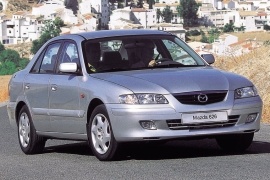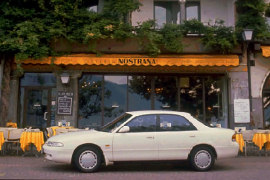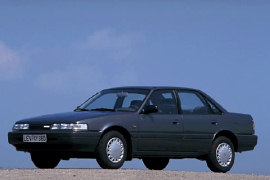MAZDA 626 Sedan Models/Series Timeline, Specifications & Photos
First production year: 1988
Engines: Gasoline, Diesel
Mazda introduced the sixth generation of the mid-size sedan 626 in 1997 and built it with Ford when the two carmakers made the AutoAlliance International.
Even though there were some variations between the American, the European, and the Australasian versions, the 626 shared some components. They were all based on the same GF platform, which meant independent suspension in all corners.
Mazda tried to make the car looks subtle, and it made it too well. It didn't stand out in a parking lot. Its chromed slat on top of the small grille and narrow but wide headlights didn't have anything special. While the same carmaker created inspired shapes for the RX7, it couldn't do the same for a car that was supposed to sell in large numbers. The windshield and the rear windscreen had about the same angle tilted toward the roof. The four-door version, which was popular in the U.S. and Japan, didn't feature an additional glass area behind the rear doors but provided a remote-opening trunk.
Inside, the carmaker created a roomy interior, but the rear passengers were disturbed by a tall center tunnel. That came with the platform, which Mazda used for the all-wheel-drive versions available in Japan. On the base trim levels, the 626 featured velour upholstery, but the leather seats were available on the upper trim level. At the front, the rounded dashboard sported a center stack for the climate control unit and the audio system.
Under the hood, Mazda installed a mix of engines either built by it or carried over from Ford Motor Company. A five-speed manual or a four-speed automatic was available, depending on the powerplant and the country where the vehicle was sold.
The fifth generation of the Mazda 626 was introduced in 1991 in Japan and in the following year in Europe. The U.S. version was introduced in 1992 as a 1993 model.
In 1991, Mazda was already involved in a partnership with Ford Motor Co. and that led to jointly developed vehicles which, in some situations, seemed to be competitors in the same market. For instance, the Mazda 626 was introduced in Europe in 1992, but in the following year, the first Ford Mondeo started to compete against it.
The biodesign trend just begun and Mazda chose it for the 626. The rounded edges, narrow headlights and curved panels made the car look smaller than it was. The body-colored door-mirrors were new for the model. The 626 featured a short wheelbase for its size and that led to big overhangs.
Inside, the 2.61 m (102”) wheelbase led to a decent interior room for the rear passengers, but smaller than other cars from its segment. The instrument cluster kept the speedometer in the middle and sent the tachometer on the left, while on the right the constructor grouped with the fuel level gauge and the coolant temperature dial. Strangely, the cruise control buttons were placed behind the steering wheel, under the instrument cluster.
Despite being a long car, Mazda didn't install the 4Wheel-Steering system which is developed in the '80s and it was present on the previous generation. Under the hood, there was a choice of gasoline and diesel engines. For the former, there was an inline-four and a V6 for the U.S. market. In Europe, it was sold mostly with 4-cylinders only.
The fourth generation of the Mazda 626 was one of Japan's most comfortable vehicles, and it featured an electronic all-wheel-steering system.
While still trying to find a design identity, Mazda introduced a wedged style sedan on the market in 1988. It was the 626, a vehicle built on a new platform and an independent rear suspension, which greatly improved the rear seats passengers' comfort.
With its rectangular, horizontal headlights and a shy try to soften its edges, the Mazda 6 wasn't everyone's candy. The Japanese carmaker didn't clearly understand the European's design taste, so it decided to try the market and convince it with its well-built products. All four doors were kept the same as those installed on the hatchback and the station-wagon versions. It featured a smaller triangular window between the rear doors and the D-pillar. In the back, the wide rectangular taillights were horizontally mounted for better visibility from behind.
Inside, the Japanese designers installed a curved dashboard with a hump above the instrument cluster. It didn't feature the usual angled cuts from most of its competitors on the market. The air-vents were integrated into the center stack and above the median line of the dash. All the sedans featured comfortable front bucket seats.
The independent suspension in all corners made the car very comfortable, and the engine lineup was adequate for its customers. Mazda offered a choice of diesel and gasoline engines for the 626. Mazda offered a turbocharged version exclusively for the North-American market.


